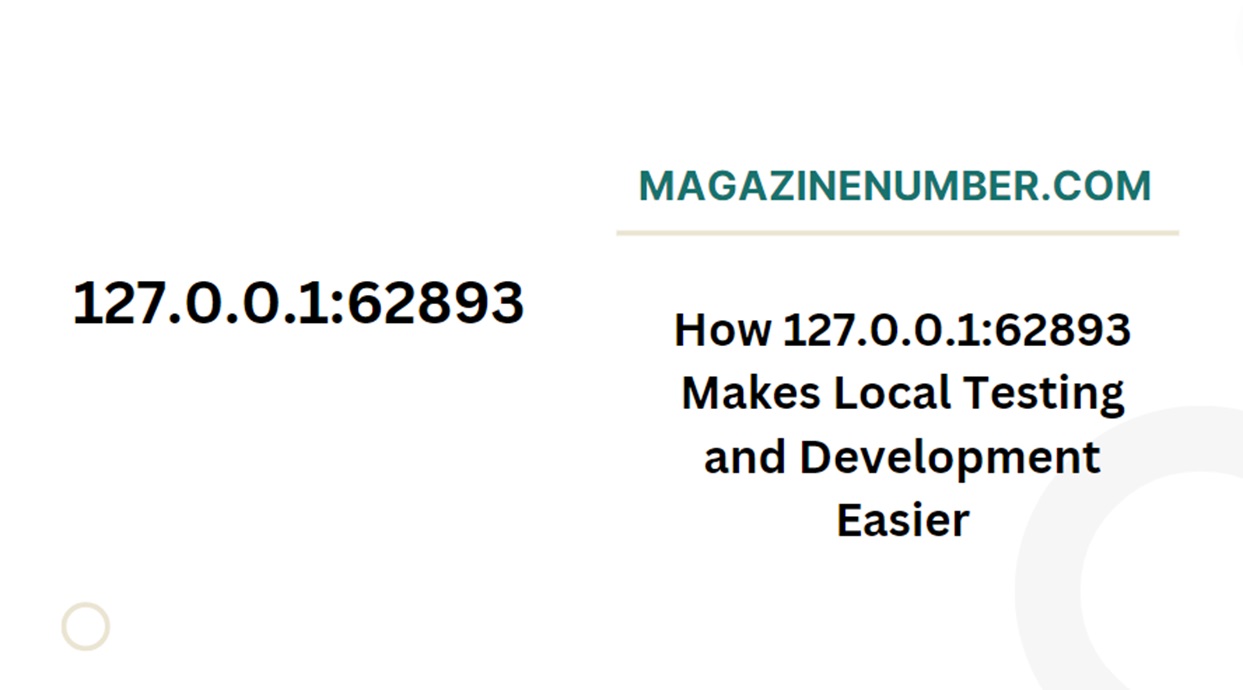Introduction
In the realm of software and network development, certain IP addresses hold special significance due to their unique functions and purposes. One such address is 127.0.0.1:62893. Though it may appear complex at first glance, understanding its components and their roles can simplify many aspects of software and network management. This article aims to unravel the intricacies of this address and explain its importance in a detailed and comprehensive manner.
Table of Contents
What is 127.0.0.1?
127.0.0.1 is a loopback address, commonly referred to as “localhost.” In networking, it serves a crucial function: it allows a computer to communicate with itself. This address is part of the IPv4 address range and is reserved specifically for loopback testing. The concept of loopback addresses is also present in IPv6, where the loopback address is ::1.
Loopback addresses are used to test networking applications without needing a physical network connection. When a request is sent to 127.0.0.1, it is redirected back to the same machine, effectively allowing the system to send and receive data to itself.
Understanding the Port Number: 62893
An IP address alone is not sufficient for detailed networking tasks. This is where port numbers come into play. A port number is a way to identify specific processes or network services running on a computer. When an IP address is followed by a colon and a number, such as 127.0.0.1:62893, it indicates that the address is associated with a specific port.
In this example, 62893 is the port number. Ports range from 0 to 65535, with certain ports being reserved for specific services. For instance, port 80 is reserved for HTTP traffic, while port 443 is reserved for HTTPS traffic. Ports above 1023 are known as ephemeral ports and are typically used for temporary communication.
The Role of 127.0.0.1:62893 in Software Development
In software development, particularly in web development and network programming, the use of 127.0.0.1:62893 (or similar configurations) is essential for several reasons:
- Local Testing Environment: Developers can test their applications locally by running them on their own machines. This allows them to simulate how the application would behave in a live environment without actually deploying it to a server. Using the loopback address ensures that the application runs in isolation, which is ideal for testing and debugging.
- Debugging and Troubleshooting: When an application fails to work as expected, developers need to diagnose and fix the issues. By running the application locally, they can use various debugging tools to step through the code, inspect variables, and monitor network traffic. The loopback address simplifies this process by keeping the data within the same machine.
- Network Configuration Testing: Before deploying an application to a production environment, it’s crucial to ensure that the network configuration is correct. This includes testing the application’s ability to handle various types of network traffic, manage connections, and respond to requests. The loopback address allows developers to conduct these tests without affecting other network users.
- Security Testing: Security is a critical aspect of software development. Using 127.0.0.1:62893, developers can perform security tests, such as penetration testing and vulnerability scanning, in a controlled environment. This helps identify potential security flaws and fix them before the application is exposed to real users.
Practical Applications and Benefits
Beyond development and testing, the loopback address 127.0.0.1:62893 has several practical applications and benefits in network management and daily computing tasks:
- Web Server Testing: Developers often run web servers locally to test websites or web applications. By using 127.0.0.1:62893, they can ensure that their web server is correctly configured and capable of handling HTTP requests. This is a common practice in environments using technologies like Apache, Nginx, and Node.js.
- Database Management: Many database systems, such as MySQL, PostgreSQL, and MongoDB, can be run locally for development and testing purposes. Developers connect to these databases using loopback addresses to execute queries, manage data, and test database-driven applications without the need for remote connections.
- API Development and Testing: Application Programming Interfaces (APIs) are crucial components of modern software applications. Developers create and test APIs on their local machines using loopback addresses to ensure they function correctly. This includes verifying endpoints, checking data formats, and simulating various request scenarios.
- Virtual Machines and Containers: Virtualization technologies like Docker and virtual machines (VMs) often use loopback addresses for internal communication. For instance, a developer might run multiple Docker containers on their machine, each listening on different ports of 127.0.0.1. This setup allows for efficient resource usage and easy management of containerized applications.
- Service Orchestration: In complex applications with multiple microservices, developers use loopback addresses to run and test individual services locally. Tools like Kubernetes and Docker Compose facilitate the orchestration of these services, enabling developers to simulate a production-like environment on their local machines.
Enhancing Security with Localhost
The use of localhost addresses plays a significant role in enhancing the security of a system. Here’s how:
- Isolation from External Networks: By using 127.0.0.1, applications are isolated from external networks, reducing the risk of exposure to external threats. This is particularly important during the development and testing phases when the application may not yet be fully secure.
- Secure Development Environment: A secure development environment is crucial for protecting sensitive code and data. Loopback addresses ensure that network communication during development remains within the same machine, minimizing the risk of data leaks and unauthorized access.
- Blocking Unwanted Traffic: System administrators can configure firewalls and security settings to block unwanted traffic to specific ports. By restricting access to certain ports on 127.0.0.1, administrators can prevent malicious activities and unauthorized access to sensitive services.
- Testing and Mitigating Attacks: Security professionals use localhost addresses to test and mitigate various types of cyberattacks, such as DDoS attacks, SQL injection, and cross-site scripting (XSS). By simulating attacks in a controlled environment, they can identify vulnerabilities and implement appropriate security measures.
Accessing and Configuring 127.0.0.1:62893
Accessing and configuring 127.0.0.1:62893 involves several steps, depending on the operating system and the specific use case. Here’s a general guide for setting up and using this loopback address on different platforms:
Windows Users:
- Open Command Prompt: Press the Windows key, type “cmd,” and press Enter.
- Check IP Configuration: Type
ipconfigand press Enter. This command displays the network configuration, including the loopback address 127.0.0.1. - Run a Local Server: To run a local server on port 62893, you can use various server applications. For example, with Python, you can run a simple HTTP server by navigating to the desired directory and typing
python -m http.server 62893. - Access the Server: Open a web browser and navigate to
http://127.0.0.1:62893to access the local server.
Linux Users:
- Open Terminal: Press Ctrl + Alt + T to open the terminal.
- Check IP Configuration: Type
ifconfigand press Enter to view the network configuration. - Run a Local Server: Similar to Windows, you can use various server applications. For instance, you can use Python or other web server software to run a server on port 62893.
- Access the Server: Open a web browser and navigate to
http://127.0.0.1:62893.
Mac Users:
- Open Terminal: Press Command + Space, type “Terminal,” and press Enter.
- Check IP Configuration: Type
ifconfigand press Enter. - Run a Local Server: You can use Python or other server applications to run a server on port 62893.
- Access the Server: Open a web browser and navigate to
http://127.0.0.1:62893.
Common Issues and Troubleshooting
While working with localhost addresses, you may encounter various issues. Here are some common problems and their solutions:
Server Not Running: If you cannot access the server at 127.0.0.1:62893, ensure that the server application is running and listening on the correct port. Check the server logs for any error messages and restart the server if necessary.
Port Conflicts: If port 62893 is already in use by another application, you will need to choose a different port. You can check for open ports using tools like netstat or lsof and configure your server to use an available port.
Firewall Restrictions: Firewalls can block access to certain ports, including localhost ports. Ensure that your firewall settings allow traffic to and from 127.0.0.1:62893. You may need to create a firewall rule to permit this traffic.
Network Configuration Issues: Incorrect network configurations can prevent access to localhost addresses. Verify that your network settings are correct and that there are no conflicts or misconfigurations.
Advanced Usage Scenarios
Beyond the basics, there are advanced scenarios where 127.0.0.1:62893 can be particularly useful:
Developing Microservices: Microservices architecture involves building small, independent services that communicate with each other. Developers can run multiple microservices on their local machines, each listening on different ports of the loopback address. This allows for efficient development and testing of microservices without deploying them to a remote server.
Using Docker Containers: Docker containers provide a lightweight and portable environment for running applications. Developers can run multiple containers on their machines, each using different ports on the loopback address for internal communication. Docker Compose can be used to orchestrate these containers, simplifying the management of complex applications.
Running Virtual Machines: Virtual machines (VMs) offer another way to run multiple isolated environments on a single machine. Developers can configure VMs to use different ports on the loopback address for communication between the host and the virtualized environments. This setup is useful for testing applications in different operating systems and configurations.
Simulating Network Conditions: Tools like network simulators and emulators can simulate various network conditions, such as latency, packet loss, and bandwidth limitations. By using 127.0.0.1:62893, developers can test how their applications perform under different network conditions without affecting actual network traffic.
Conclusion
The IP address 127.0.0.1:62893, while seemingly complex, is a fundamental tool in software and network development. Its role as a loopback address allows developers to test and debug applications locally, ensuring that they function correctly before deployment. By understanding its significance and applications, developers can leverage 127.0.0.1:62893 to create more robust, secure, and efficient software.
From local testing environments to advanced usage scenarios like microservices and Docker containers, the loopback address serves a critical function in modern computing. It enhances security, facilitates efficient development, and provides a controlled environment for testing and troubleshooting. Mastering the use of 127.0.0.1:62893 is essential for anyone involved in software development or network management, making it an invaluable asset in the technical toolkit.
By demystifying this address and exploring its various applications, we can appreciate its importance in creating high-quality, reliable software and maintaining secure, efficient network environments. Whether you are a seasoned developer or a newcomer to the field, understanding and utilizing 127.0.0.1:62893 will undoubtedly enhance your capabilities and contribute to your success in the world of technology.
Read our blogs – Magazine Number.



